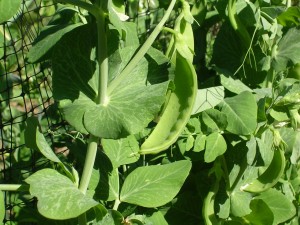There are few vegetables more anticipated than peas (Pisum sativum) in spring. Fresh peas are seldom found in grocery stores, even in season, making them even more essential in the garden. While I grew up eating English peas (where you shell them), now we have snow peas and snap peas where you can eat the pods and all. It makes pea growing and eating even easier. Most of our pea crop ends up being eaten in the garden, because it’s so easy to walk down the rows munching happily as you go. Beside eating them raw, peas are great sauteed, steamed, or added to a soup or stew. You can also harvest the young tendrils (curly shoots) and add those to salads as well.
When to Plant
Pea seeds can germinate in soils as cool as 45F, so as soon as the soil dries out enough to turn, plant your peas. Most likely it will be April or early May in our region. I’ve had good success sowing a fall crop in late July or early August for harvest in October.
Where to Plant
Pea seed can rot if sitting in cool, wet soil in spring. It’s important to build an 8-inch tall raised bed 4-feet wide before planting. The raised beds allows the soil to dry out and warm up faster. Peas need full sun to grow their best. Most varieties grow 4- to 7-feet tall and need a trellis or fence to grab on and grow up. Peas are great grown along an existing fence or building.
How to Plant
Amend the soil with compost before planting. To hasten germination, and reduce the chance of seeds rotting in the ground, soak pea seeds overnight in warm water before planting. This starts the germination process so they sprout faster. I construct my fence for tall varieties in the middle of my raised bed. I use 6 foot tall wire fence supported every 5 feet with a wooden or metal post. Sow seeds in rows on either side of the fence. I get more pea plants, and peas, that way. Sow seeds 2 inches apart and space the rows 1 foot apart. If you’re growing dwarf pea varieties that only grow 2-feet tall, you won’t need a fence.
Care and Maintenance
Since peas are a legume and fix nitrogen from the air, they need little extra fertilizer. Keep the soil cool and weed free by hand weeding after germination and then mulching the rows with a layer of straw or untreated grass clippings.
Beside pea seeds rotting in the cool, wet soils, there are a few other problems you’ll find with your pea plants. Diseases, such as fusarium wilt, pythium, and powdery mildew, can be avoided by growing disease resistant varieties and rotating your crops, not planting a pea family crop in the same area for 3 years. Aphids will love the young pea shoots. Spray insecticidal soap to control them. Rabbits and woodchuck love the tender pea plants. Fence your garden before peas emerge to keep these critters away.
Harvest
Peas start maturing a few months after planting. Harvest English peas when the pods are full and round. Pick daily and don’t allow the pods to become over mature or they will be tough and starchy tasting. Harvest snap peas when the peas inside start to form, but don’t fill the pod. Harvest snow or flat-podded peas when the peas just begin to form.
Additional Information
Some good English pea varieties to grow include ‘Green Arrow’ and ‘Premium’ which both grow 30 inches tall. ‘Tall Telephone’ is an old fashioned variety that grows 6 feet tall. For snap peas, ‘Super Sugar Snap’ is a disease resistant version of the classic ‘Sugar Snap’ and grows 5 feet tall. ‘Sugar Sprint’ grows 2 feet tall and produces prolifically. ‘Oregon Sugar Pod II’ is a good snow pea variety and ‘Golden Sweet’ produces yellow colored pods on 4-foot tall plants.
Text excepted from the Northeast Vegetable and Fruit Gardening book.



